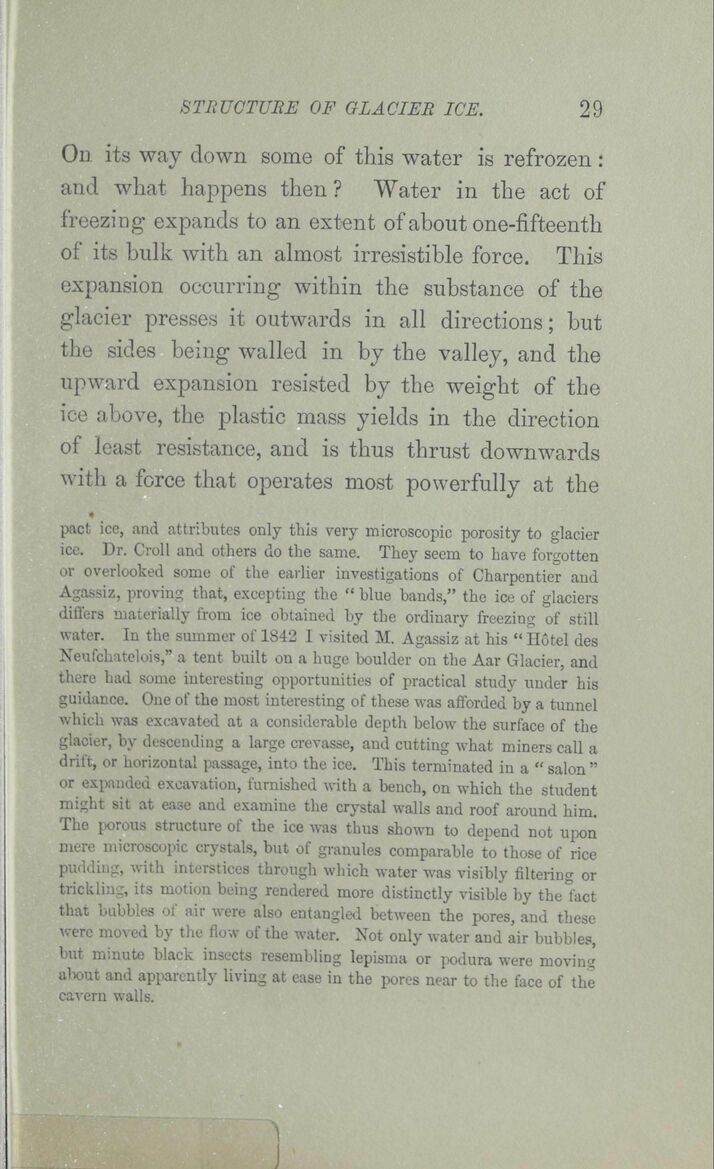
Full resolution (JPEG)
- On this page / på denna sida
- Sidor ...

<< prev. page << föreg. sida << >> nästa sida >> next page >>
Below is the raw OCR text
from the above scanned image.
Do you see an error? Proofread the page now!
Här nedan syns maskintolkade texten från faksimilbilden ovan.
Ser du något fel? Korrekturläs sidan nu!
This page has been proofread at least once.
(diff)
(history)
Denna sida har korrekturlästs minst en gång.
(skillnad)
(historik)
On its way down some of this water is refrozen:
and what happens then? Water in the act of
freezing expands to an extent of about one-fifteenth
of its bulk with an almost irresistible force. This
expansion occurring within the substance of the
glacier presses it outwards in all directions; but
the sides being walled in by the valley, and the
upward expansion resisted by the weight of the
ice above, the plastic mass yields in the direction
of least resistance, and is thus thrust downwards
with a force that operates most powerfully at the
**[1]
[1] [**contin. from prev. pg**]ice, and attributes only this very microscopic porosity to glacier
ice. Dr. Croll and others do the same. They seem to have forgotten
or overlooked some of the earlier investigations of Charpentier and
Agassiz, proving that, excepting the “blue bands,” the ice of glaciers
differs materially from ice obtained by the ordinary freezing of still
water. In the summer of 1842 I visited M. Agassiz at his “Hôtel des
Neufchatelois,” a tent built on a huge boulder on the Aar Glacier, and
there had some interesting opportunities of practical study under his
guidance. One of the most interesting of these was afforded by a tunnel
which was excavated at a considerable depth below the surface of the
glacier, by descending a large crevasse, and cutting what miners call a
drift, or horizontal passage, into the ice. This terminated in a “salon”
or expanded excavation, furnished with a bench, on which the student
might sit at ease and examine the crystal walls and roof around him.
The porous structure of the ice was thus shown to depend not upon
mere microscopic crystals, but of granules comparable to those of rice
pudding, with interstices through which water was visibly filtering or
trickling, its motion being rendered more distinctly visible by the fact
that bubbles of air were also entangled between the pores, and these
were moved by the flow of the water. Not only water and air bubbles,
but minute black insects resembling lepisma or podura were moving
about and apparently living at ease in the pores near to the face of the
cavern walls.
<< prev. page << föreg. sida << >> nästa sida >> next page >>
Project Runeberg, Tue Dec 12 14:41:12 2023
(aronsson)
(diff)
(history)
(download)
<< Previous
Next >>
https://runeberg.org/withladies/0053.html



